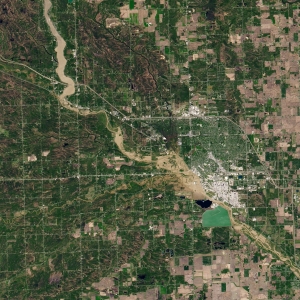The Stream, May 22, 2020: Mid-Michigan Floodwaters Mix with Contaminant Ponds at Dow Chemical Plant
The Global Rundown
Mid-Michigan reels from two dam failures, and officials say resulting floodwaters mingled with contaminant ponds at Midland’s Dow Chemical plant. The death toll mounts from Cyclone Amphan, the strongest cyclone to strike Bangladesh and eastern India in more than a decade. Covid-19 reveals water inequalities in rural areas of the southern United States. A report by the U.S. EPA explains how federal dams raising water levels in the Pacific Northwest’s Snake and Columbia Rivers, threaten steelhead and salmon populations. Experts in Indianapolis, Indiana, urge business owners to flush their water lines before reopening to prevent possible contamination from bacteria or heavy metals.
“Utilities need to be moving water through their system, and building owners need to be moving water through their systems. If they maintain some consistent use, if they have been flushing, then it’s probably not a problem. But if they haven’t been flushing and the water’s basically sat stagnant there, what they need to do is contact the health department and they will probably be told to flush.” –Andrew Whelton, an associate professor at Purdue University, in reference to the risks of dormant water in buildings that have been temporarily closed due to Covid-19. Officials in Indianapolis, Indiana, join a growing global call for careful handling of stagnant water in pipelines, which could be growing dangerous bacteria or accumulating heavy metals like lead or copper. Indy Star
In context: ‘Deadly’ Consequences If Stagnant Water in Shuttered Buildings Is Not Properly Addressed.
Latest WaterNews from Circle of Blue
As Pandemic Magnifies Navajo Nation Water Deficit, Coronavirus Funding Questions Arise — Navajo Nation president and residents want to use federal Covid-19 funds on water infrastructure. Is that allowed?
CDC, EPA Change Building Reopening Guidance After Acknowledging Error — Agencies admit incorrect guidance in documents intended to protect people from a deadly waterborne disease.
By The Numbers
82+ Latest death toll from Cyclone Amphan, which struck Bangladesh and the Indian state of West Bengal on Tuesday. The cyclone was the most powerful to strike the region in over a decade. Rescuers are searching for survivors in the midst of devastated landscapes and collapsed homes. Reuters
35 Record-breaking crest of flooding in mid-Michigan that occurred following failures of the Edenville and Sanford dams. The previous high water mark was 33.9 feet in 1986, which spurred one of Michigan’s worst floods in modern history. The floodwaters, which were especially devastating in Midland, reportedly mingled with contaminant ponds at the city’s Dow chemical plant, although Dow says that no chemicals were released into the environment. Detroit Free Press
Science, Studies, and Reports
A newly-published report by the U.S. Environmental Protection Agency discusses how federal dams on the Snake and Columbia river system in the Pacific Northwest are raising river temperatures above 68°F (20°C), making the waterways dangerously warm for salmon and steelhead fish. Debates over the environmental dangers of the dams have been ongoing for years. Associated Press
On the Radar
In the United States, parts of the rural South are among many worldwide communities where gaps in water equality are being starkly highlighted by the Covid-19 crisis. Many households, including those in Mississippi, Louisiana, and others, do not have piped water, and oftentimes rely on shallow or contaminated wells. This makes frequent handwashing difficult, along with maintaining a steady supply of potable water. U.S. News & World Report
Kayla Ritter is a recent graduate of Michigan State University, where she studied International Relations and Teaching English to Speakers of Other Languages. She is currently based in Manton, Michigan. Kayla enjoys running, writing, and traveling. Contact Kayla Ritter





Leave a Reply
Want to join the discussion?Feel free to contribute!